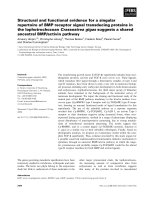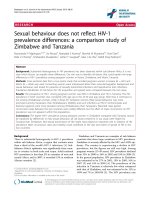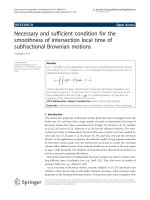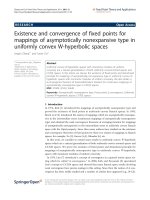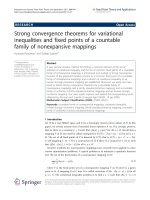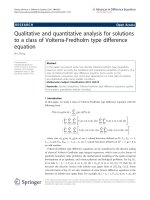báo cáo hóa học: " Existence and iterative approximation for generalized equilibrium problems for a countable family of nonexpansive mappings in banach spaces" pdf
Bạn đang xem bản rút gọn của tài liệu. Xem và tải ngay bản đầy đủ của tài liệu tại đây (301.52 KB, 12 trang )
RESEARC H Open Access
Existence and iterative approximation for
generalized equilibrium problems for a countable
family of nonexpansive mappings in banach
spaces
Uthai Kamraksa
1
and Rabian Wangkeeree
1,2*
* Correspondence:
1
Department of Mathematics,
Faculty of Science, Naresuan
University, Phitsanulok 65000,
Thailand
Full list of author information is
available at the end of the article
Abstract
We first prove the existence of a solution of the generalized equilibrium problem
(GEP) using the KKM mapping in a Banach space setting. Then, by virtue of this
result, we construct a hybrid algorithm for finding a common element in the
solution set of a GEP and the fixed point set of countable family of nonexpansive
mappings in the frameworks of Banach spaces. By means of a projection technique,
we also prove that the sequences generated by the hybrid algorithm converge
strongly to a common element in the solution set of GEP and common fixed point
set of nonexpansive mappings.
AMS Subject Classification: 47H09, 47H10
Keywords: Banach space, Fixed point, Metric projection, Generalized equilibrium pro-
blem, Nonexpansive mapping
1. Introduction
Let E be a real Banach space with the dual E*andC beanonemptyclosedconvex
subset of E.Wedenoteby
N
and
R
the sets of positive integers and re al numbers,
respectively. Also, we denote by J the normalized duality mapping from E to 2
E*
defined by
Jx =
{
x
∗
∈ E
∗
:
x, x
∗
=
||
x
||
2
=
||
x
∗
||
2
}
, ∀x ∈ E
,
where 〈·,·〉 denotes the generalized duality pairing. We know that if E is smooth, then
J is single-valued and if E is uniformly smooth, then J is uniformly norm-to-norm con-
tinuous on bounded subsets of E. We s hall still denote by J the single-valued duality
mapping. Let
f
: C × C →
R
be a bifunction and A : C ® E* be a nonlinear mapping.
We consider the following generalized equilibrium problem (GEP):
Find u ∈ C such that f
(
u, y
)
+ Au, y − u≥0, ∀y ∈ C
.
(1:1)
The set of such u Î C is denoted by GEP (f), i.e.,
GEP
(
f
)
= {u ∈ C : f
(
u, y
)
+ Au, y − u≥0, ∀y ∈ C}
.
Kamraksa and Wangkeeree Fixed Point Theory and Applications 2011, 2011:11
/>© 2011 Kamraksa and Wangkeeree; lice nsee Sp ringer. This is an Open Access article distr ibu ted under the terms of the Creati ve
Commons Attribution License ( which permits unrestricted use, distribu tion, and
reproduction in any medium, provided the original work is properly cited.
Whenever E = H aHilbertspace,theproblem(1.1)wasintroducedandstudiedby
Takahashi and Takahashi [1]. Similar problems have been studied extensively
recently. In the case of A ≡ 0, GEP (f) is denoted by EP (f). In the case of f ≡ 0, EP
is also denoted by VI(C, A). Problem (1.1) is very general in the sense that it
includes, as spacial cases, optimization problems, variational inequalities, minimax
problems, the Nash eq uilibrium problem in noncooperative games, and others; see,
e.g., [2,3]. A mapping T : C ® E is called nonexpansive if ||Tx - Ty|| ≤ ||x - y|| for
all x, y Î C.DenotebyF (T )thesetoffixedpointsofT ,thatis,F (T )={x Î C :
Tx = x}. A mapping A : C ® E* is called a-inverse-strongly monotone, if there exists
an a > 0 such that
Ax − A
y
, x −
y
≥α||Ax − A
y
||
2
, ∀x,
y
∈ C
.
It is easy to see that if A : C ® E*isana-inverse-strongly monotone mapping, then
it is 1/a- Lipschitzian.
In 1953, Mann [4] introduced the following iterative procedure to approximate a
fixed point of a nonexpansive mapping T in a Hilbert space H:
x
n+1
= α
n
x
n
+
(
1 − α
n
)
Tx
n
, ∀n ∈ N
,
(1:2)
where the initial point x
0
is taken in C arbitrarily and {a
n
} is a sequence in [0, 1].
However, we note that Manns iteration process (1.2) has only weak convergence, in
general; for instance, see [5-7].
Let C be a nonempty, closed, and convex subset o f a Banach space E and {T
n
}be
sequence of mappings of C into itself such that
∞
n
=1
F(T
n
) =
∅
.Then,{T
n
}issaidto
satisfy the NST-condition if for each bounded sequence {z
n
} ⊂ C,
lim
n
→
∞
||z
n
− T
n
z
n
|| =
0
implies
ω
w
(z
n
) ⊂
∞
n
=1
F(T
n
)
,whereω
w
(z
n
) is the set of all weak cluster points of
{z
n
}; see [8-10].
In 2008, Takahash i et al. [11] ha s adapted Nakajo and Takahashi’s [12] idea to mod-
ify the process (1.2) so that strong convergence has been guaranteed. They proposed
the following modification for a family of nonexpansive mappings in a Hilbert space:
x
0
Î H, C
1
= C ,
u
1
= P
C
1
x
0
and
⎧
⎨
⎩
y
n
= α
n
u
n
+(1− α
n
)T
n
u
n
,
C
n+1
= {z ∈ C
n
: ||y
n
− z|| ≤ ||u
n
− z||}
,
u
n+1
= P
C
n+1
x
0
, n ∈ N ,
(1:3)
where 0 ≤ a
n
≤ a <1forall
n ∈
N
.Theyprovedthatif{T
n
} satisfies the NST-
condition , then {u
n
} generated by (1.3) converges strongly to a common fixed point of
T
n
.
Recently, motivated by Nakajo and Takahashi [12] and Xu [13], Matsushita and
Takahashi [14] introduced the iterative algorithm for finding fixed points of nonexpan-
sive mappings in a uniformly convex and smooth Banach space: x
0
= x Î C and
⎧
⎨
⎩
C
n
= co{z ∈ C : ||z − Tz|| ≤ t
n
||x
n
− Tx
n
||}
,
D
n
= {z ∈ C : x
n
− z, J(x − x
n
)≥0},
x
n+1
= P
C
n
∩D
n
x, n ≥ 0,
(1:4)
Kamraksa and Wangkeeree Fixed Point Theory and Applications 2011, 2011:11
/>Page 2 of 12
where
co
D
denotes the convex closure of the set D,{t
n
} is a sequence in (0,1) with t
n
® 0, and
P
C
n
∩D
n
is the metric projection from E ont o C
n
∩ D
n
. They proved that {x
n
}
generated by (1.4) converges strongly to a fixed point of T .
Very recently, Kimura and Nakajo [15] investigated iterative schemes for finding com-
mon fixed points of a family of nonexpansive mappings and proved strong convergence
theorems by using the Mosco convergence technique in a uniformly convex and smooth
Banach space. In particular, they proposed the following algorithm: x
1
= x Î C and
⎧
⎨
⎩
C
n
= co{z ∈ C : ||z − T
n
z|| ≤ t
n
||x
n
− T
n
x
n
||}
,
D
n
= {z ∈ C : x
n
− z, J(x − x
n
)≥0},
x
n+1
= P
C
n
∩D
n
x, n ≥ 0,
(1:5)
where {t
n
} is a sequ ence in (0,1) with t
n
® 0asn ® ∞. They proved that if {T
n
} satis-
fies the NST-condition, then {x
n
} converges strongly to a common fixed point of T
n
.
Motivated and inspired by N akajo and Takahashi [12], Takahash i et al. [11], Xu [13],
Masushita and Takahashi [14], and Kimura and Nakajo [15], we introduce a hybrid
projection algorithm for finding a common element in t he solution set of a GEP and
the common fixed point set of a family of nonexpansive mappings in a B anach space
setting.
2. Preliminaries
Let E be a real Banach space and let U ={x Î E :||x|| = 1} be the unit sphere of E.
A Banach space E is said to be strictly convex if for any x, y Î U,
x =
y
implies —|x +
y
|| < 2
.
It is also said to be uniformly convex if for each ε Î (0, 2], there exists δ >0such
that for any x, y Î U,
||x − y|| ≥ ε implies —|x + y|| < 2
(
1 − δ
).
It is known that a unifo rmly convex Banach space is reflexive and strictly convex.
Define a function δ: [0, 2] ® [0, 1] called the modulus of convexity of E as follows:
δ(ε)=inf
1 −||
x + y
2
|| : x, y ∈ E, ||x|| = ||y|| =1, ||x − y|| ≥ ε
.
Then, E is uniformly convex if and only if δ(ε) > 0 for all ε Î (0, 2]. A Banach space
E is said to be smooth if the limit
lim
t→0
||
x + ty
||
−
||
x
||
t
(2:1)
exists for all x, y Î U. Let C be a nonempty, closed, and convex subset of a reflexive,
strictly convex and smooth Banach space E. Then, for any x Î E, there exists a unique
point x
0
Î C such that
||x
0
− x|| ≤ min
y
∈C
||y − x||
.
The mapping P
C
: E ® C defined by P
C
× = x
0
is called t he metric projection from
E onto C. Let x Î E and u Î C. Then, it is known that u = P
C
× if and only if
u − y, J
(
x − u
)
≥
0
(2:2)
Kamraksa and Wangkeeree Fixed Point Theory and Applications 2011, 2011:11
/>Page 3 of 12
for all y Î C; see [16] for more details. It is well known that if P
C
is a metric
projection from a real Hilbert space H onto a nonempty, closed, and convex subset
C,thenP
C
is nonexpansive . However, in a genera l Banach space, this fact is not
true.
In the sequel, we will need the following lemmas.
Lemma 2.1. [17]Let E be a uniformly convex Banach space,{a
n
} be a sequence of real
numbers such that 0<b ≤ a
n
≤ c <1for all n ≥ 1, and {x
n
} and {y
n
} be sequences in E
such that lim sup
n®∞
||x
n
|| ≤ d, lim sup
n®∞
||y
n
|| ≤ dandlim
n®∞
||a
n
x
n
+(1-a
n
)
y
n
|| = d. Then, lim
n®∞
||x
n
- y
n
|| = 0.
Lemma 2.2. [18]Let C be a bounded, closed, and convex subset of a uniformly convex
Banach space E. Then, there exists a strictly increasing, convex, and continuous function
g : [0, ∞) ® [0, ∞) such thatg (0) = 0 and
γ
T
n
i=1
λ
i
x
i
−
n
i=1
λ
i
Tx
i
≤ max
1≤j≤k≤n
(||x
j
− x
k
|| − ||Tx
j
− Tx
k
||
)
for all
n ∈
N
,{x
1
, x
2
, , x
n
} ⊂ C,{l
1
, l
2
, , l
n
} ⊂ [0, 1] with
n
i
=1
λ
i
=
1
and nonexpan-
sive mapping T of C into E.
Following Bruck’s [19] idea, we know the following result for a convex combination
of nonexpansive mappings which is considered by Aoyama et al. [20] and Kimura and
Nakajo [15].
Lemma 2.3.[15]Let C be a nonempty, closed, and convex subset of a uniformly
convex Banach space E and {S
n
} be a family of nonexpansive mappings of C into itself
such that
F =
∞
n
=1
F(S
n
) =
∅
. Let
{β
k
n
}
be a family of nonnegative numbers wi th indices
n,
k ∈
N
with k ≤ n such that
(i)
n
k
=1
β
k
n
=
1
for every
n ∈
N
;
(ii)
lim
n→∞
β
k
n
>
0
for every
k ∈
N
and let
T
n
= α
n
I +(1− α
n
)
n
k
=1
β
k
n
S
k
for all
n ∈
N
, where {a
n
} ⊂ [a, b] for some a, b
Î (0, 1) with a ≤ b. Then,{T
n
} is a family of nonexpansive mappings of C into itself
with
∞
n
=1
F(T
n
)=
F
and satisfies the NST-condition.
Now, let us turn to following well-known concept and result.
Definition 2.4. Let B be a subset of topological vector space X. A mapping G : B ® 2
X
is called a KKM mapping if
co{x
1
, x
2
, , x
m
}⊂
m
i
=1
G(x
i
)
for x
i
Î B and i = 1, 2, , m,
where coA denotes the convex hull of the set A.
Lemma 2.5. [21]Let B be a nonempty subset of a Hausdorff topological vector space ×
and let G : B ® 2
X
be a KK M mapping. If G(x) is closed for all × Î B and is compact
for at least one x Î B, then ⋂
xÎB
G(x) ≠ ∅.
3. Existence results of gep
Motivated by Takahashi and Zembayashi [22], and Ceng and Yao [23], we next prove
the following crucial lemma concerning the GEP in a strictly convex, reflexive, and
smooth Banach space.
Kamraksa and Wangkeeree Fixed Point Theory and Applications 2011, 2011:11
/>Page 4 of 12
Theorem 3.1. Let C be a nonempty, bounded, closed, and convex subset of a smooth,
strictly convex, and reflexive Banach space E, let f be a bifunction from C × Cto
R
satisfying (A1)-(A4), where
(A1) f(x, x)=0for all x Î C;
(A2) f is monotone, i.e. f(x, y)+f(y, x) ≤ 0 for all x, y Î C;
(A3) for all y Î C, f(., y) is weakly upper semicontinuous;
(A4) for all x Î C, f(x,.) is convex.
Let A be a-inverse strongly monotone of C into E*. For all r >0and × Î E, define the
mapping S
r
: E ® 2
C
as follows:
S
r
(x)={z ∈ C : f (z, y)+Az, y − z +
1
r
y − z, J(z − x)≥0, ∀y ∈ C}
.
(3:1)
Then, the following statements hold:
(1) for each x Î E, S
r
(x) ≠ ∅;
(2) S
r
is single-valued;
(3) 〈S
r
(x)-S
r
(y), J(S
r
x - x)〉 ≤ 〈S
r
(x)-S
r
(y), J(S
r
y - y)〉 for all x, y Î E;
(4) F (S
r
)=GEP (f);
(5) GEP(f) is nonempty, closed, and convex.
Proof.(1)Letx
0
be any gi ven point in E. For each y Î C, we define the mapping G :
C ® 2
E
by
G(y)={z ∈ C : f (z, y)+Az, y − z +
1
r
y − z, J(z − x
0
)≥0} for all y ∈ C
.
It is easily seen that y Î G(y), and hence G(y). ≠ ∅
(a) First, we will show that G is a KKM mapping. Suppose that there exists a finite
subset {y
1
, y
2
, , y
m
}ofC and a
i
> 0 with
m
i
=1
α
i
=
1
such that
ˆ
x =
m
i
=1
α
i
y
i
∈ G(y
i
)
for
all i = 1, 2, , m. It follows that
f (
ˆ
x, y
i
)+A
ˆ
x, y
i
−
ˆ
x +
1
r
y
i
−
ˆ
x, J(
ˆ
x − x
0
) < 0, for all i =1,2, , m
.
By (A1) and (A4), we have
0=f (
ˆ
x,
ˆ
x)+A
ˆ
x,
ˆ
x −
ˆ
x +
1
r
ˆ
x −
ˆ
x, J(
ˆ
x − x
0
)
≤
m
i
=1
f (
ˆ
x, y
i
)+A
ˆ
x, y
i
−
ˆ
x +
1
r
y
i
−
ˆ
x, J(
ˆ
x − x
0
)
< 0
,
which is a contradiction. Thus, G is a KKM mapping on C.
(b) Next, we show that G(y)isclosedforally Î C.Let{z
n
}beasequenceinG(y)
such that z
n
® z as n ® ∞. It then follows from z
n
Î G(y) that,
f (z
n
, y)+Az
n
, y − z
n
+
1
r
y − z
n
, J(z
n
− x)≥0
.
(3:2)
Kamraksa and Wangkeeree Fixed Point Theory and Applications 2011, 2011:11
/>Page 5 of 12
By (A3), the continuity of J, and the lower semicontinuity of || · ||
2
, we obtain from
(3.2) that
0 ≤ lim inf
n→∞
[f (z
n
, y)+Az
n
, y − z
n
+
1
r
y − z
n
, J(z
n
− x
0
)]
≤ lim sup
n→∞
[f (z
n
, y)+Az
n
, y − z
n
+
1
r
y − x
0
, J(z
n
− x
0
) +
1
r
x
0
− z
n
, J(z
n
− x
0
)]
= lim sup
n→∞
[f (z
n
, y)+Az
n
, y − z
n
+
1
r
y − x
0
, J(z
n
− x
0
)−
1
r
||z
n
− x
0
||
2
]
≤ lim sup
n→∞
f (z
n
, y) + lim sup
n→∞
Az
n
, y − z
n
+
1
r
lim sup
n→∞
y − x
0
, J(z
n
− x
0
)−
1
r
lim inf
n→∞
||z
n
− x
0
||
2
≤ f(z, y)+Az, y − z +
1
r
y − x
0
, J(z − x
0
)−
1
r
||z − x
0
||
2
= f(z, y)+Az, y − z +
1
r
y − x
0
, J(z − x
0
)−
1
r
z − x
0
, J(z − x
0
)
= f(z, y)+Az, y − z +
1
r
y − z, J(z − x
0
).
This shows that z Î G(y), and hence G(y) is closed for all y Î C .
(c) We prove that G(y) is weakly compact. We now equip E with the weak topology.
Then, C, as closed, bounded convex subset in a reflexive space, is weakly compact.
Hence, G(y) is also weakly compact.
Using (a), (b), and (c) and Lemma 2.5, we have ⋂
xÎC
G(y) ≠ ∅. It is easily seen that
S
r
(x
0
)=
y
∈C
G(y
)
Hence, s
r
(x
0
) ≠ ∅. Since x
0
is arbitrary, we can conclude that s
r
(x) ≠ ∅ for all x Î E.
(2) We prove that S
r
is single-valued. In fact, for x Î C and r >0,letz
1
, z
2
Î S
r
(x).
Then,
f (z
1
, z
2
)+Az
1
, z
2
− z
1
+
1
r
z
2
− z
1
, J(z
1
− x)≥0
.
and
f (z
2
, z
1
)+Az
2
, z
1
− z
2
+
1
r
z
1
− z
2
, J(z
2
− x)≥0
.
Adding the two inequalities and from the co ndition (A2) and monotonicity of A,we
have
0 ≤ f(z
1
, z
2
)+f (z
2
, z
1
)+Az
1
, z
2
− z
1
+ Az
2
, z
1
− z
2
+
1
r
z
2
− z
1
, J(z
1
− x) − J(z
2
− x)
≤Az
1
− Az
2
, z
2
− z
1
+
1
r
z
2
− z
1
, J(z
1
− x) − J(z
2
− x)
≤−α||Az
1
− Az
2
||
2
+
1
r
z
2
− z
1
, J(z
1
− x) − J(z
2
− x)
≤
1
r
z
2
− z
1
, J(z
1
− x) − J(z
2
− x),
(3:3)
and hence,
z
2
− z
1
, J
(
z
1
− x
)
− J
(
z
2
− x
)
≥0
.
Hence,
0 ≤z
2
− z
1
, J
(
z
1
− x
)
− J
(
z
2
− x
)
=
(
z
2
− x
)
−
(
z
1
− x
)
, J
(
z
1
− x
)
− J
(
z
2
− x
)
.
Kamraksa and Wangkeeree Fixed Point Theory and Applications 2011, 2011:11
/>Page 6 of 12
Since J is monotone and E is strictly convex, we obtain that z
1
- x = z
2
- x and hence
z
1
= z
2
.
Therefore S
r
is single-valued.
(3) For x, y Î C, we have
f (S
r
x, S
r
y)+AS
r
x, S
r
y − S
r
x +
1
r
S
r
y − S
r
x, J(S
r
x − x)≥
0
and
f (S
r
y, S
r
x)+AS
r
y, S
r
x − S
r
y +
1
r
S
r
x − S
r
y, J(S
r
y − y)≥0
.
Again, adding the two inequalities, we also have
AS
r
x − AS
r
y, S
r
y − S
r
x + S
r
y − S
r
x, J
(
S
r
x − x
)
− J
(
S
r
y − y
)
≥0
.
It follows from monotonicity of A that
S
r
y − S
r
x, J
(
S
r
x − x
)
≤S
r
y − S
r
x, J
(
S
r
y − y
)
.
(4) It is easy to see that
z
∈ F(S
r
) ⇔ z = S
r
z
⇔ f (z, y)+Az, y − z +
1
r
y − z, J(z − z)≥0, ∀y ∈
C
⇔ f (z, y)+Az, y − z≥0, ∀y ∈ C
⇔ z ∈ GEP
(
f
)
.
Hence, F (S
r
)=GEP (f).
(5) Finally, we claim that GEP (f) is nonempty, closed, and convex. For each y Î C,
we define the mapping Θ : C ® 2
E
by
(
y
)
= {x ∈ C : f
(
x, y
)
+ Ax, y − x≥0}
.
Since y Î Θ (y), we have Θ(y ) ≠ ∅ We prove that Θ is a KKM mapping on C.
Supposethatthereexistsafinitesubset{z
1
, z
2
, , z
m
}ofC and a
i
>0with
m
i
=1
α
i
=
1
such that
ˆ
z
=
m
i
=1
α
i
z
i
∈ (z
i
)
for all i = 1, 2, , m. Then,
f
(
ˆz, z
i
)
+ Aˆz, z
i
−ˆz < 0, i =1,2, , m
.
From (A1) and (A4), we have
0=f (ˆz, ˆz)+Aˆz, ˆz −ˆz≤
m
i
=1
α
i
f (ˆz, z
i
)+Aˆz, z
i
−ˆz
< 0
,
which is a contradiction. Thus, Θ is a KKM mapping on C.
Next, we prove that Θ (y)isclosedforeachy Î C. For any y Î C,let{x
n
}beany
sequence in Θ (y)suchthatx
n
® x
0
. We claim that x
0
Î Θ (y). Then, for each y Î C,
we have
f
(
x
n
, y
)
+ Ax
n
, y − x
n
≥0
.
By (A3), we see that
f (x
0
, y)+Ax
0
, y − x
0
≥lim sup
n
→∞
f (x
n
, y) + lim
n→∞
Ax
n
, y − x
n
≥0
.
Kamraksa and Wangkeeree Fixed Point Theory and Applications 2011, 2011:11
/>Page 7 of 12
This shows that x
0
Î Θ (y)andΘ(y)isclosedforeachy Î C. Thus,
y
∈C
(y)=GEP(f
)
is also closed.
We observe that Θ (y) is weakly compact. In fact, since C is bounded, closed, and
conv ex, we also have Θ(y) is weakly compact in the weak topology. By Lemma 2.5, we
can conclude that
y
∈C
(y)=GEP(f ) =
∅
.
Finally, we prove that GEP (f) is convex. In fact, let u, v Î F (S
r
) and z
t
= tu+(1 - t)v
for t Î (0, 1). From (3), we know that
S
r
u − S
r
z
t
, J
(
S
r
z
t
− z
t
)
− J
(
S
r
u − u
)
≥0
.
This yields that
u − S
r
z
t
, J
(
S
r
z
t
− z
t
)
≥0
.
(3:4)
Similarly, we also have
v − S
r
z
t
, J
(
S
r
z
t
− z
t
)
≥ 0
.
(3:5)
It follows from (3.4) and (3.5) that
||z
t
− S
r
z
t
||
2
= z
t
− S
r
z
t
, J(z
t
− S
r
z
t
)
= tu − S
r
z
t
, J(z
t
− S
r
z
t
) +(1− t)v − S
r
z
t
, J(z
t
− S
r
z
t
)
≤
0.
Hence, z
t
Î F (S
r
)=GEP (f) and hence GEP (f) is convex. This completes the proof.
4. Strong convergence theorem
In this section, we prove a strong convergence theorem using a hybrid projection algo-
rithm in a uniformly convex and smooth Banach space.
Theorem 4.1. Let E be a uniformly convex and smooth Banach space and C be a
nonempty, bounded, closed, and convex subset of E. Let f be a bifunction from C × Cto
R
satisfying (A1)-(A4), A an a-inverse strongly monotone mappin g of C into E*and
{T
n
}
∞
n
=
0
a sequence of nonexpansive mappings of C into itself such that
:=
∞
n
=
0
F(T
n
) ∩ GEP(f ) = ∅
and suppose that
{T
n
}
∞
n
=
0
satisfies the NST-condition. Let
{x
n
} be the sequence in C generated by
⎧
⎪
⎪
⎪
⎪
⎪
⎪
⎨
⎪
⎪
⎪
⎪
⎪
⎪
⎩
x
0
∈ C, D
0
= C,
C
n
= co{z ∈ C : ||z − T
n
z|| ≤ t
n
||x
n
− T
n
x
n
||}, n ≥ 1,
u
n
∈ C such that f(u
n
, y)+Au
n
, y − u
n
+
1
r
n
y − u
n
, J(u
n
− x
n
)≥0, ∀y ∈ C, n ≥ 0
,
D
n
= {z ∈ D
n−1
: u
n
− z, J(x
n
− u
n
)≥0}, n ≥ 1,
x
n+1
= P
C
n
∩D
n
x
0
, n ≥ 0,
(4:1)
where {t
n
} and {r
n
} are sequences which satisfy the following conditions:
(C1) {t
n
} ⊂ (0, 1) and lim
n®∞
t
n
=0;
(C2) {r
n
} ⊂ (0, 1) and lim inf
n®∞
r
n
>0.
Then, the sequence {x
n
} converges strongly to P
F
x
0
.
Kamraksa and Wangkeeree Fixed Point Theory and Applications 2011, 2011:11
/>Page 8 of 12
Proof. First, we rewrite the algorithm (4.1) as the following:
⎧
⎪
⎪
⎨
⎪
⎪
⎩
x
0
∈ C, D
0
= C,
C
n
= co{z ∈ C : ||z − T
n
z|| ≤ t
n
||x
n
− T
n
x
n
||}, n ≥ 1
,
D
n
= {z ∈ D
n−1
: S
r
n
x
n
− z, J(x
n
− S
r
n
x
n
)≥0}, n ≥ 1
,
x
n+1
= P
C
n
∩D
n
x
0
, n ≥ 0,
(4:2)
where S
r
is the mapping defined by (3.1) for all r > 0. We first show that th e
sequence {x
n
} is well defined. It is easy to verify that C
n
∩ D
n
is closed and convex
and Ω ⊂ C
n
for all n ≥ 0. Next, we prove that Ω ⊂ C
n
∩ D
n
.SinceD
0
= C,wealso
have Ω ⊂ C
0
∩ D
0
.SupposethatΩ ⊂ C
k -1
∩ D
k -1
for k ≥ 2. It follows from
Lemma (3) that
S
r
k
x
k
− S
r
k
u, J(S
r
k
u − u) − J(S
r
k
x
k
− x
k
)≥0
,
for all u Î Ω. This implies that
S
r
k
x
k
− u, J(x
k
− S
r
k
x
k
)≥0
,
for all u Î Ω. Hence, Ω ⊂ D
k
. By the mathematical induction, we get that Ω ⊂ C
n
∩
D
n
for each n ≥ 0 and hence {x
n
} is well defined. Let w = P
F
x
0
.SinceΩ ⊂ C
n
∩ D
n
and
x
n+1
= P
C
n
∩D
n
x
0
, we have
||
x
n+1
− x
0
||
≤
||
w − x
0
||
, n ≥ 0
.
(4:3)
Since {x
n
} is bounded, there exists a subsequenc e
{x
n
i
}
of {x
n
} such that
x
n
i
v ∈
C
.
Since x
n+2
Î D
n+1
⊂ D
n
and
x
n+1
=
P
C
n
∩D
n
x
0
, we have
||
x
n+1
− x
0
||
≤
||
x
n+2
− x
0
||.
Since {x
n
- x
0
} is bounded, we have lim
n®∞
||x
n
- x
0
|| = d for some a constant d.
Moreover, by the convexity of D
n
, we also have
1
2
(x
n+1
+ x
n+2
) ∈ D
n
and hence
|
|x
0
− x
n+1
|| ≤
x
0
−
x
n+1
+ x
n+2
2
≤
1
2
(
||x
0
− x
n+1
|| + ||x
0
− x
n+2
||
)
.
This implies that
lim
n→∞
1
2
(x
0
− x
n+1
)+
1
2
(x
0
− x
n+2
)
= lim
n→∞
x
0
−
x
n+1
+ x
n+2
2
= d
.
By Lemma 2.1, we have lim
n ®∞
||x
n
- x
n+1
|| = 0.
Next, we show that
v ∈
∞
n
=
0
F(T
n
)
.Sincex
n+1
Î C
n
and t
n
>0,thereexists
m ∈
N
,
{l
0
, l
1
, , l
m
} ⊂ [0, 1] and {y
0
, y
1
, , y
m
} ⊂ C such that
m
i=1
λ
i
=1,
x
n+1
−
m
i=0
λ
i
y
i
< t
n
, and —|y
i
− T
n
y
i
|| ≤ t
n
||x
n
− T
n
x
n
|
|
Kamraksa and Wangkeeree Fixed Point Theory and Applications 2011, 2011:11
/>Page 9 of 12
for each i = 0, 1, , m. Since C is bounded, by Lemma 2.2, we have
||x
n
− T
n
x
n
|| ≤ ||x
n
− x
n+1
|| +
x
n+1
−
m
i=0
λ
i
y
i
+
m
i=0
λ
i
y
i
−
m
i=0
λ
i
T
n
y
i
+
m
i=0
λ
i
T
n
y
i
− T
n
m
i=0
λ
i
y
i
+
T
n
m
i=0
λ
i
y
i
− T
n
x
n
≤ 2||x
n
− x
n+1
|| +(2+2M)t
n
+ γ
−1
max
0≤i≤j≤m
(||y
i
− y
j
|| − ||T
n
y
i
− T
n
y
j
||)
≤ 2||x
n
− x
n+1
|| +(2+2M)t
n
+ γ
−1
max
0≤i≤j≤m
(||y
i
− T
n
y
i
|| − ||y
j
− T
n
y
j
||)
≤ 2||x
n
− x
n+1
|| +
(
2+2M
)
t
n
+ γ
−1
(
4Mt
n
)
,
where M =sup
n≥ 0
||x
n
- w||. It follows from (C1) that lim
n ®∞
||x
n
- T
n
x
n
|| = 0.
Since { T
n
} satisfies the NST-condition, we have
v ∈
∞
n
=
0
F(T
n
)
.
Next, we show that v Î GEP (f). By the construction of D
n
,weseefrom(2.2)that
S
r
n
x
n
= P
D
n
x
n
. Since x
n+1
Î D
n
, we obtain
|
|x
n
− S
r
n
x
n
|| ≤ ||x
n
− x
n+1
|| → 0
,
as n ® ∞. From (C2), we also have
1
r
n
J(x
n
− S
r
n
x
n
)
=
1
r
n
||x
n
− S
r
n
x
n
|| → 0
,
(4:4)
as n ® ∞. Since {x
n
} is bounded, it has a subsequence
{x
n
i
}
which weakly converges
to some v Î E.
By (4.4), we also have
S
r
n
i
v
. By the definition of
S
r
n
j
, for each y Î C, we obtain
f (S
r
n
i
x
n
i
, y)+AS
r
n
i
x
n
i
, y − S
r
n
i
x
n
i
+
1
r
n
i
y − S
r
n
i
x
n
i
, J(S
r
n
i
x
n
i
− x
n
i
)≥0
.
By (A3) and (4.4), we have
f
(
v, y
)
+ Av, y − v≥0, ∀y ∈ C
.
This shows that v Î GEP (f) and hence
v ∈ :=
∞
n
=
0
F(T
n
) ∩ GEP(f
)
.
Note that w = P
Ω
x
0
. Finally, we show that x
n
® w as n ® ∞. By the weakly lower
semicontinuity of the norm, it follows from (4.3) that
|
|x
0
− w|| ≤ ||x
0
− v|| ≤ lim inf
i→∞
||x
0
− x
n
i
|| ≤ lim sup
i
→∞
||x
0
− x
n
i
|| ≤ ||x
0
− w||
.
This shows that
lim
i
→∞
||x
0
− x
n
i
|| = ||x
0
− w|| = ||x
0
− v|
|
and v = w. Since E is uniformly convex, we obtain that
x
0
− x
n
i
→ x
0
−
w
. It follows
that
x
n
i
→
w
. Hence, we have x
n
® w as n ® w. This completes the proof.
5. Deduced theorems
If we take f ≡ 0 and A ≡ 0 in Theorem 4.1, then we obtain the following result.
Kamraksa and Wangkeeree Fixed Point Theory and Applications 2011, 2011:11
/>Page 10 of 12
Theorem 5.1. Let E be a uniformly convex and smooth Banach space, C a nonempty,
bounded, closed, and convex subset of E and
{T
n
}
∞
n
=
0
a sequence of nonexpansive map-
pings of C into itself such that
:=
∞
n
=
0
F(T
n
) =
0
and suppose that
{T
n
}
∞
n
=
0
satisfies the
NST-condition. Let {x
n
} be the sequence in C generated by
⎧
⎨
⎩
x
0
∈ C, D
0
= C,
C
n
= co{z ∈ C : ||z − T
n
z|| ≤ t
n
||x
n
− T
n
x
n
||}, n ≥ 1
,
x
n+1
= P
C
n
x
0
, n ≥ 0.
(5:1)
If {t
n
} ⊂ (0, 1) and lim
n®∞
t
n
=0,then {x
n
} converges strongly to P
Ω
x
0
.
Remark 5.2. By Lemma 2.3, if we define
T
n
= α
n
I +(1− α
n
)
n
k
=1
β
k
n
S
k
for all n ≥ 0
in Theorems 3.1 and 5.1, then the theorems also hold.
If we take T
n
≡ I, the identit y mapping on C, for all n ≥ 0 in Theorem 4.1, then we
obtain the following result.
Theorem 5.3. Let E be a uniformly convex and smooth Banach space, C a nonempty,
bounded, closed, and convex subset of E. Let f be a bifunction from C × C to
R
satisfying
(A1)-(A 4) an d A an a-inverse strongly monotone mapping of C into E*. Let {x
n
} be the
sequence in C generated by
⎧
⎪
⎪
⎪
⎪
⎪
⎨
⎪
⎪
⎪
⎪
⎪
⎩
x
0
∈
C
, D
0
=
C
,
u
n
∈ C such that f (u
n
, y)+Au
n
, y − u
n
+
1
r
n
y − u
n
, J(u
n
− x
n
)≥0, ∀y ∈ C, n ≥ 0
,
D
n
= {z ∈ D
n−1
: u
n
− z, J(x
n
− u
n
)≥0}, n ≥ 1,
x
n+1
= P
D
n
x
0
, n ≥ 0.
(5:2)
If {r
n
} ⊂ (0, 1) and lim inf
n®∞
r
n
>0,then {x
n
} converges strongly to P
GEP (f)
x
0
.
If we take A ≡ 0 in Theorem 4.1, then we obtain the following result concerning an
equilibrium problem in a Banach space setting.
Theorem 5.4. Let E be a uniformly convex and smooth Banach space and C be a
nonempty, bounded, closed, and convex subset of E. Let f be a bifunction from C × C to
R
satisfying (A1)-(A4) and let
{T
n
}
∞
n
=
0
be a sequence of nonexpansive mappings of C into
itself such that
:=
∞
n
=
0
F(T
n
) ∩ EP(f ) =
∅
and suppose that
{T
n
}
∞
n
=
0
satisfies the NST-
condition. Let {x
n
} be the sequence in C generated by
⎧
⎪
⎪
⎪
⎪
⎪
⎪
⎪
⎪
⎨
⎪
⎪
⎪
⎪
⎪
⎪
⎪
⎪
⎩
x
0
∈ C, D
0
= C,
C
n
= co{z ∈ C : ||z − T
n
z|| ≤ t
n
||x
n
− T
n
x
n
||}, n ≥ 1,
u
n
∈ C such that f (u
n
, y)+
1
r
n
y − u
n
, J(u
n
− x
n
)≥0, ∀y ∈ C, n ≥ 0
,
D
n
= {z ∈ D
n−1
: u
n
− z, J(x
n
− u
n
)≥0}, n ≥ 1,
x
n+1
= P
C
n
∩D
n
x
0
, n ≥ 0,
(5:3)
where {t
n
} and {r
n
} are sequences which satisfy the conditions:
(C1) {t
n
} ⊂ (0, 1) and lim
n®∞
t
n
=0;
(C2) {r
n
} ⊂ (0, 1) and lim inf
n®∞
r
n
>0.
Then, the sequence {x
n
} converges strongly to P
Ω
x
0
.
Kamraksa and Wangkeeree Fixed Point Theory and Applications 2011, 2011:11
/>Page 11 of 12
Abbreviations
GEP: generalized equilibrium problem.
Acknowledgements
U. Kamraksa was supported by grant from under the program “Strategic Scholarships for Frontier Research Network
for the Ph.D.” Program Thai Doctoral degree from the Office of the Higher Education Commission, Thailand. The
project was supported by the “Centre of Excellence in Mathematics” under the Commission on Higher Education,
Ministry of Education, Thailand and the grant from under the program Strategic Scholarships for Frontier Research
Network for the Ph.D. Program Thai Doctoral degree from the Office of the Higher Education Commission.
Author details
1
Department of Mathematics, Faculty of Science, Naresuan University, Phitsanulok 65000, Thailand
2
Centre of
Excellence in Mathematics, Che, Si Ayutthaya Road, Bangkok 10400, Thailand
Received: 26 December 2010 Accepted: 28 June 2011 Published: 28 June 2011
References
1. Takahashi, S, Takahashi, W: Strong convergence theorem for a generalized equilibrium problem and a nonexpansive
mappings in a Hilbert space. J Nonlinear Anal. 69, 1025–1033 (2008). doi:10.1016/j.na.2008.02.042
2. Kohsaka, F, Takahashi, W: Strong convergence of an iterative sequence for maximal monotone operators in a Banach
space. Abstr Appl Anal. 3, 239–249 (2004)
3. Martinet, B: Regularisation d’inequations variationnelles par approximations successives. Rev Fr Autom Inf Res Oper. 4,
154–159 (1970)
4. Mann, WR: Mean value methods in iteration. Proc Am Math Soc. 4, 506–510 (1953). doi:10.1090/S0002-9939-1953-
0054846-3
5. Bauschke, HH, Matouskova, E, Reich, S: Projection and proximal point methods: convergence results and counterex-
amples. Nonlinear Anal. 56, 715–738 (2004). doi:10.1016/j.na.2003.10.010
6. Genal, A, Lindenstrass, J: An example concerning fixed points. Isr J Math. 22,81–86 (1975). doi:10.1007/BF02757276
7. Reich, S: Weak convergence theorems for nonexpansive mappings in Banach spaces. J Math Anal Appl. 67, 274–276
(1979). doi:10.1016/0022-247X(79)90024-6
8. Bauschke, HH, Combettes, PL: A weak-to-strong convergence principle for Fejer-Monotone methods in Hilbert spaces.
Math Oper Res. 26, 248–264 (2001). doi:10.1287/moor.26.2.248.10558
9. Nakajo, K, Shimoji, K, Takahashi, W: Strong convergence to common fixed points of families of nonexpansive mappings
in Banach spaces. J Nonlinear Convex Anal. 8,11–34 (2007)
10. Nakajo, K, Shimoji, K, Takahashi, W: Strong convergence theorems by the hybrid method for families of nonexpansive
mappings in Hilbert spaces. Taiwan J Math. 10, 339–360 (2006)
11. Takahashi, W, Takeuchi, Y, Kubota, R: Strong convergence theorems by hybrid methods for families of nonexpansive
mappings in Hilbert spaces. J Math Anal Appl. 341, 276–286 (2008). doi:10.1016/j.jmaa.2007.09.062
12. Nakajo, K, Takahashi, W: Strong convergence theorems for nonexpansive mappings and nonexpansive semigroups. J
Math Anal Appl. 279, 372–379 (2003). doi:10.1016/S0022-247X(02)00458-4
13. Xu, H-K: Strong convergence of approximating fixed point sequences for nonexpansive mappings. Bull Aust Math Soc.
74, 143–151 (2006). doi:10.1017/S0004972700047535
14. Matsushita, S, Takahashi, W: Approximating fixed points of nonexpansive mappings in a Banach space by metric
projections. Appl Math Comput. 196, 422–425 (2008). doi:10.1016/j.amc.2007.06.006
15. Kimura, Y, Nakajo, K: Some characterizations for a family of nonexpansive mappings and convergence of a generated
sequence to their common fixed point. Fixed Point Theory Appl. (2010)
16. Takahashi, W: Nonlinear Functional Analysis. Yokohama Publishers (2000)
17. Zeidler, E: Nonlinear Functional Analysis and Its Applications, vol. I: Fixed-Point Theorems. Springer, New York (1986)
18. Bruck, RE: On the convex approximation property and the asymptotic behaviour of nonlinear contractions in Banach
spaces. Isr J Math. 38, 304–314 (1981). doi:10.1007/BF02762776
19. Bruck, RE: Properties of fixed-point sets of nonexpansive mappings in Banach spaces. Trans Am Math Soc. 179, 251–262
(1973)
20. Aoyama, K, Kimura, Y, Takahashi, W, Toyoda, M: Approximation of common fixed points of a countable family of
nonexpansive mappings in a Banach space. Nonlinear Anal.
67, 2350–2360 (2007). doi:10.1016/j.na.2006.08.032
21. Fan, K: A generalization of Tychonoffs fixed point theorem. Math Ann. 142, 305–310 (1961). doi:10.1007/BF01353421
22. Takahashi, W, Zembayashi, K: Strong and weak convergence theorems for equilibrium problems and relatively non-
expansive mappings in Banach spaces. J Nonlinear Anal. 70,45–57 (2009). doi:10.1016/j.na.2007.11.031
23. Ceng, L-C, Yao, J-C: A hybrid iterative scheme for mixed equilibrium problems and fixed point problems. J Comput
Appl Math. 214, 186–201 (2008). doi:10.1016/j.cam.2007.02.022
doi:10.1186/1687-1812-2011-11
Cite this article as: Kamraksa and Wangkeeree: Existence and iterative approximation for generalized equilibrium
problems for a countable family of nonexpansive mappings in banach spaces. Fixed Point Theory and Applications
2011 2011:11.
Kamraksa and Wangkeeree Fixed Point Theory and Applications 2011, 2011:11
/>Page 12 of 12
